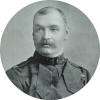Eyre Crabbe

Eyre Macdonnell Stewart Crabbe CB (1852 – 8 March 1905) was a Grenadier Guards officer who fought in the Sudan campaign to rescue General Gordon and in the Second Boer War.[1]
His father was Colonel Eyre John Crabbe of the 74th Regiment, himself the son of Colonel Joseph Crabbe of the East India Company's army. His mother, Elmina Stewart, came from a Jamaica planter family. After education at Harrow School he joined the Grenadier Guards in 1871 and was one of the first ensigns not to have to pay for a commission, following the Cardwell reforms. During service in Ireland as a young lieutenant he married in 1876 Emily Constance Jameson, a descendant of John Jameson, the founder of the Dublin distilling family.
His army speciality for several years was as a musketry instructor, but in 1882 he helped organise the logistical operations for the British attack on Alexandria. In 1884 he volunteered for the Sudan campaign as part of the Guards Camel Corps and took part in the battle of Abu Klea.[2]
In 1898 he became commanding officer of the 3rd Battalion, the Grenadier Guards, and led them to South Africa in 1899. He was wounded at the Battle of Belmont 1899 in November and mentioned in dispatches, and was back with his battalion in time for the Battle of Magersfontein in December. In March 1900 his battalion took part in the march on Bloemfontein and the pacification of the Orange Free State. He escorted Piet Cronjé into captivity, and commented in a letter home: "It is a curious idea taking one’s wife & family with one to the wars & must be inconvenient for many reasons but it is rather the fashion in these parts. Living in a river bed & being shot at every day seems an odd fancy for a lady." [3] On 23 March he was badly wounded when a small foraging party, mainly of officers, which he was leading, including Colonel Codrington of the Coldstream Guards, was ambushed at Karee Siding; his adjutant was killed. This episode was generally regarded as "plucky" but widely reported round the world as an example of the "over-confidence and recklessness" (in the words of the New York Tribune[4]) of British officers. However Crabbe was back with his battalion by the end of April and as they marched north towards Pretoria on 1 May Crabbe was observed and commented on by Arthur Conan Doyle: "Here is another man worth noting. You could not help noting him if you tried. A burly, broad-shouldered man with full, square, black beard over his chest, his arm in a sling, his bearing a medieval knight-errant. It is Crabbe, of the Grenadier Guards." [5]
Crabbe led his battalion to Pretoria and on to the border with Portuguese East Africa at Koomati Poort but their hopes of returning to England with Field Marshal Lord Roberts in November were dashed. Instead they were sent from Transvaal to Cape Colony to prevent De Wet entering the Cape. When the character of the war changed in early 1901 to that of blockhouses, concentration camps, and mobile columns against Boer guerillas, Crabbe (now a C.B.) became commander of a mobile column, not rejoining his battalion till March 1902. He had dangerous brushes with Fouche in May and with Kritzinger in July 1901, and led the forces which defeated and killed Van der Merwe in September and Hildebrand in November. Following the end of the war in June 1902, he returned to England on the SS Carisbrook Castle, landing at Southampton in August.[6]
In November 1902 Crabbe became AQMG of 1st Army Corps at Aldershot and in May 1903 Chief Staff Officer of 4th Army Corps also at Aldershot. He died suddenly of a heart attack soon after arriving for work on 8 March 1905, aged only 52.[7] His wife had predeceased him and he left four sons and four daughters. The youngest son, Tempest, a subaltern in the Grenadier Guards, was killed at the Battle of Loos in 1915, the third, Lewis, ended a distinguished naval career as Vice Admiral, having commanded a ship at the Battle of Jutland in 1916, been Senior Naval Officer in the Persian Gulf and on the Yangtze, and Flag Officer at Liverpool in 1939. One of the eldest twin daughters, Daisy, married John Ronald Moreton Macdonald of Largie Castle, the youngest, Iris, Sir William Lawrence, 3rd Baronet. His daughter Violet married Brig. Robert Hugh Willan DSO MC.
References
- ↑ F. Lloyd and A. Russell, First or Grenadier Guards 2nd and 3rd Battalions in South Africa 1899-1902
- ↑ Count Gleichen With the Camel Corps up the Nile (1888) (Crabbe is referred to as "C" or "the musketoon")
- ↑ http://samilitaryhistory.org/diaries/emsc.html Letter of 28 February 2000
- ↑ New-York tribune, 25 March 1900, page 3
- ↑ Sir Arthur Conan Doyle, Memories and Adventures, pp 141-2
- ↑ "The Army in South Africa - troops returning home". The Times (36827). London. 23 July 1902. p. 7.
- ↑ The Times, Thursday, 9 Mar 1905